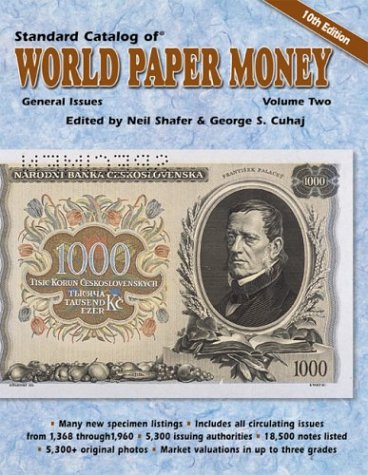|
|||||||||||
| Home | |||

Custom Search
|
|||
United States of America - Handbooks for the banknote collector
If one seriously collects US banknotes, one has to have some kind of informations as to what notes exists, and - not the least important - which notes are valuable. All government issued US banknotes are still redeemable at face value, though no longer for silver or gold coin as the text on some notes indicates. Large size notes generally are worth more than face value; while small size notes vary greatly in value. Even quite recent notes may have a value much greater than face value - but to acquire such a note, you have to know what to look for. One of my favourite histories is about myself. I had been collecting foreign notes for many years as a boy, but when the first catalog of Norwegian banknotes came, I started collecting circulating notes. My greatest find came as I visited a bar one evening, and received a note as change. It was worn, but a close inspection revealed that this was a replacement note. When I came home, I found this to be the second such note in existence! - I later sold it for 40 times its face value.
So the lesson is that you need information to pick out what is of value. For the banknote collector, there is a number of books that can give you the necessary information. The general banknote collector, collecting world banknotes, needs his "Pick" - the catalog you find in the table near the end of this page.
If you specialize in US currency, you need a specialized catalog. Or, rather, you need some catalogs - there are two main types: the handbook, and the price list. The handbook gives detailed information about the notes, how many were issued, details etc., while the price list gives you current prices for most banknotes. Investing in the relevant handbooks, then buying a cheaper price list regularly, will be my recommended way of handling this.
A cheap and regularly updated price guide is 2005 Blackbook Price Guide to United States Paper Money (37th edition), with a new edition every year. This is also a very handy tome for those collecting circulating notes by year, signature, district or replacement notes as you can bring it with you - no need to take all notes back home before spending them - and you can tick out the notes you already have in your collection. In addition to US large and small-size notes, it lists confederate notes and fractional currency.
Paper Money of the United States: A Complete Illustrated Guide With Valuations : The Standard Reference Work on Paper Money (Paper Money of the United States, 17th ed) is a comprehensive catalog with valuations, covering all large- and small-size US currency. In addition, it lists US Military Payment certificates, Philppines Currency, fractional currency and Postage stamp currency. It also gives a bank by bank indication of National bank note scarcity.
Hessler: The Comprehensive Catalog of U.S. Paper Money: All United States Federal Currency Since 1812 covers much the same ground as the preceeding book. The National bank notes are not covered in as much detail. The introductory historical background and general information is very interesting. It also covers unissued and rejected designs and paper money circulated outside the continental US - Alaska, Hawaii, Philippines, Puerto Rico and the Virgin Islands; and Allied military currency.
Kelly: National Bank Notes: A Guide with Prices is a must if you want to collect National Bank Notes seriously. Every bank that ever issued a note is listed, with details of how many notes of any series and denomination were issued, how large an amount the bank had outstanding in 1935 and how many notes are known in a large-scale census of such notes (information about more than 200,000 notes has been collected in the census).
Standard Guide To Small Size U.S. Paper Money: 1928 To Date (Standard Guide to Small-Size U.S. Paper Money) is more limited in scope - small size notes only - but still weighs in at 1.1 pounds, 355 pages.
Another handbook, Money, Money, Money : The Meaning of the Art and Symbols on United States Paper Currency, is more of a booklet, giving you insight into the symbols and the persons on the small-size currency. No catalog, no valuations. Another book discussing (world) banknote design, without being a catalog or price quide is: The Art of Money: The History and Design of Paper Currency from Around the World. This is a truly beautiful book, filled to the brim with beautiful colour illustrations.
|
|||||||||||||||||||||
|
| US Paper Money catalogues and handbooks |
© janeriks Jan Erik Frantsvåg 2001 Reg.no. NO 983 140
831
Contact me by e-mail: mn@janeriks.no


 Pick
2: General issues 10th (2004) ed.
Pick
2: General issues 10th (2004) ed. Pick:1
Specialized issues 9th (2002) ed.
Pick:1
Specialized issues 9th (2002) ed. Pick:
Specialized issues 9th (2002) ed.
Pick:
Specialized issues 9th (2002) ed. Notgeld
Notgeld

